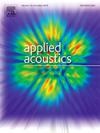Sound insulation of a lightweight lattice sandwich panel
IF 3.4
2区 物理与天体物理
Q1 ACOUSTICS
引用次数: 0
Abstract
In this study, an analytical approach based on the Reissner sandwich panel theory is presented for the analysis of sound insulation properties of a lightweight sandwich panel with lattice cores. A comparison of the sound insulation of the sandwich panel predicted using the analytical solution and finite element analysis shows that by ignoring the shear stiffness of face plates of the sandwich panel can lead to a deviation in the predicted sound insulation result, exemplified by the frequency difference of the valleys in the STL of the panel. An equivalent shear energy principle is then adopted to render a revised equivalent shear stiffness of the sandwich panel by including the contribution of the face plate shear stiffness. It is shown that the analytical STL prediction of the panel using the equivalent shear stiffness matches quite well with that using finite element analysis under a normal incident sound wave excitation. There is a deviation in the results when the sandwich panel is under an oblique sound wave excitation due to the isotropic assumption in the evaluation of the equivalent shear stiffness of the lattice core in the analytical solution. A sound insulation experiment is also carried out in the study to verify the theoretical prediction result of the sandwich panel.
求助全文
约1分钟内获得全文
求助全文
来源期刊

Applied Acoustics
物理-声学
CiteScore
7.40
自引率
11.80%
发文量
618
审稿时长
7.5 months
期刊介绍:
Since its launch in 1968, Applied Acoustics has been publishing high quality research papers providing state-of-the-art coverage of research findings for engineers and scientists involved in applications of acoustics in the widest sense.
Applied Acoustics looks not only at recent developments in the understanding of acoustics but also at ways of exploiting that understanding. The Journal aims to encourage the exchange of practical experience through publication and in so doing creates a fund of technological information that can be used for solving related problems. The presentation of information in graphical or tabular form is especially encouraged. If a report of a mathematical development is a necessary part of a paper it is important to ensure that it is there only as an integral part of a practical solution to a problem and is supported by data. Applied Acoustics encourages the exchange of practical experience in the following ways: • Complete Papers • Short Technical Notes • Review Articles; and thereby provides a wealth of technological information that can be used to solve related problems.
Manuscripts that address all fields of applications of acoustics ranging from medicine and NDT to the environment and buildings are welcome.
 求助内容:
求助内容: 应助结果提醒方式:
应助结果提醒方式:


